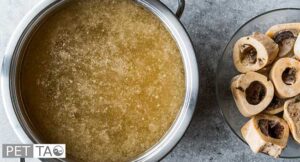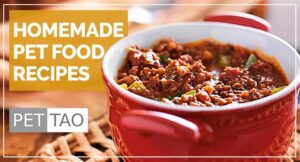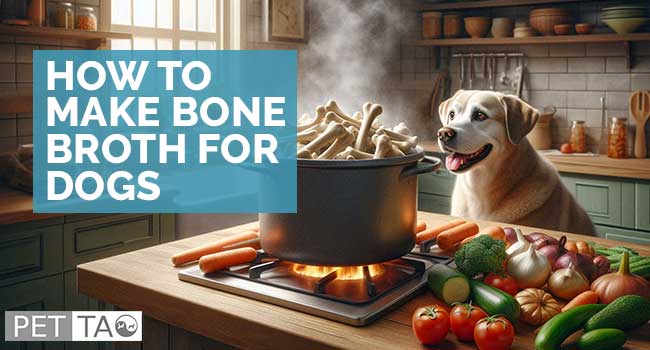Why Make Bone Broth for Dogs?
Making bone broth for dogs is easier than you might think! With just a few simple ingredients and some time, you can create a nutrient-rich base that enhances your dog’s meals. The process involves simmering bones in water to extract valuable nutrients like collagen and minerals, which support joint health, digestion, and overall vitality. Whether you’re a seasoned cook or new to preparing homemade dog food, bone broth is a straightforward way to boost your dog’s diet with minimal effort.
Nutrient-Rich and Hydrating
Homemade bone broth for dogs is a powerhouse of essential nutrients. It is rich in collagen, gelatin, glucosamine, and chondroitin, all vital for joint health, digestion, and immune support. In addition to these nutrients, bone broth is an excellent source of hydration. It provides dogs with the necessary fluids, making it especially beneficial for those not drinking enough water. The broth also replenishes electrolytes, keeping your dog well-hydrated and balanced.
Joint Health Support
One of the standout benefits of bone broth is its ability to support and maintain joint health. The collagen and gelatin found in bone broth play a crucial role in maintaining and repairing cartilage, which is essential for healthy joints. These compounds can reduce inflammation and alleviate pain, particularly in dogs suffering from arthritis or other joint issues, making bone broth a natural supplement for older dogs or those with mobility concerns.
Digestive Aid

Immune System Booster
The amino acids present in bone broth, such as glycine and proline, are key players in supporting a healthy immune system. A robust immune system helps protect your dog from infections and illnesses, ensuring they stay healthy and active. Regular consumption of bone broth can enhance your dog’s immune response, making them more resilient against common ailments.
 Skin and Coat Enhancement
Skin and Coat Enhancement
Collagen doesn’t just benefit joints; it’s also fantastic for your dog’s skin and coat. Collagen helps maintain a healthy skin barrier and promotes a shiny, lustrous coat by supporting skin elasticity and hydration. This can be particularly beneficial for dogs with dry skin or coat issues, as the nutrients in bone broth contribute to overall skin health.
Appetite Stimulation
Bone broth can be a game-changer for dogs with a reduced appetite due to illness or simply picky eaters. Its rich, savory flavor can make food more appealing, encouraging dogs to eat more readily. Adding bone broth to their meals can also ensure they receive additional nutrients, even when their appetite is low.
Low-Calorie Treat with Mineral Support

How to Make Bone Broth for Dogs
Ingredients
Here’s what you’ll need to make homemade bone broth for dogs:
- Bones: Use a variety of bones, such as beef, chicken, turkey, or lamb bones. For added nutrition, include bones with connective tissue and marrow, like knuckle bones, joints, or neck bones.
- Water: Enough to cover the bones entirely in the pot.
- Apple Cider Vinegar: 2-4 tablespoons. Apple cider vinegar helps draw out minerals from the bones.
(Optional additions):
- Vegetables: For extra flavor and nutrients, add dog-safe vegetables like carrots, celery, and parsley. Avoid onions, garlic, and other ingredients that are toxic to dogs.
- Herbs: Safe herbs like turmeric or rosemary can be added for extra health benefits, but use them sparingly.
You’ll need a few essential ingredients to make bone broth for dogs. The primary ingredient is bones, which can include a variety of bones such as beef, chicken, turkey, or lamb. For added nutrition, using bones with connective tissue and marrow, such as knuckle bones, joints, or neck bones, is beneficial.
You’ll also need enough water to completely cover the bones in your pot, along with 2-4 tablespoons of apple cider vinegar. The vinegar is crucial because it helps draw out the minerals from the bones during cooking.
Optional additions can include dog-safe vegetables like carrots, celery, and parsley, enhancing flavor and nutrient content. Some safe herbs like turmeric or rosemary can also be added for extra health benefits, but these should be used sparingly. It’s vital to avoid onions, garlic, and other ingredients that can be toxic to dogs.
Preparing and Cooking the Broth
- Prepare the Bones: Place the bones in a large pot, slow cooker, or Instant Pot. Ensure the bones are clean and fresh. If using a slow cooker, break down larger bones to fit.
- Add Water and Vinegar: Pour enough water into the pot to cover the bones by about 2 inches. Add 2-4 tablespoons of apple cider vinegar to the water. The vinegar helps to break down the bones and draw out the nutrients.
Simmer:
- Stovetop Method: Bring the water to a boil, then reduce the heat to a low simmer. Cover the pot and let it simmer for at least 12-24 hours. The longer the broth simmers, the more nutrients will be extracted from the bones.
- Slow Cooker Method: Set the slow cooker on low and cook for 24-48 hours.
Instant Pot Method: If using an Instant Pot, cook on the “Soup” or “Stew” setting for about 2-4 hours. - Strain the Broth: Remove the bones and any solid pieces from the broth after simmering. Strain the liquid through a fine mesh strainer to remove any remaining bits of bone or debris.
- Cool and Store: Allow the broth to cool completely. If desired, skim off any fat that rises to the top. Once cooled, pour the broth into storage containers. Store in the refrigerator for up to 5 days or freeze in ice cube trays for longer storage (up to 6 months).
Preparation

Once everything is in the pot, you’ll begin the cooking process. Bring the water to a boil using a stovetop, then reduce the heat to a low simmer. Cover the pot and let it simmer for at least 12-24 hours; the longer it simmers, the more nutrients will be extracted. For a slow cooker, set it on low and let it cook for 24-48 hours. If you’re using an Instant Pot, cook on the “Soup” or “Stew” setting for about 2-4 hours.
Straining and Storing the Broth
After the simmering process, it’s time to strain the broth. Remove the bones and any solid pieces, and then pour the liquid through a fine mesh strainer to catch any remaining bits of bone or debris. Once strained, allow the broth to cool completely. You may want to skim off any fat that rises to the top, though this is optional. Once cooled, transfer the broth into storage containers. It can be kept in the refrigerator for up to 5 days or frozen in ice cube trays for up to 6 months.
Serving and Safety Tips
Serving Suggestions:
- Serve the broth as a nutritious liquid treat on its own.
- Pour it over your dog’s regular food to add flavor and moisture.
- Use it to rehydrate dry kibble or mix it with homemade dog food.
When serving bone broth to your dog, you have several options. You can serve it as a nutritious liquid treat, pour it over your dog’s regular food to add flavor and moisture, rehydrate dry kibble, or mix it with homemade dog food.
Safety Tips:
- Avoid Seasonings: Do not add salt, onions, garlic, or other seasonings to the broth, as these can harm dogs.
- Bone Safety: Ensure all bones are removed before serving to avoid choking hazards.
- Portion Control: To avoid digestive upset, start with small portions, especially if your dog is not used to bone broth.
It’s essential to keep a few safety tips in mind. Avoid adding seasonings, such as salt, onions, or garlic, as these can harm dogs. Ensure all bones are thoroughly removed from the broth before serving to prevent choking hazards. Additionally, start with small portions, mainly if your dog is not accustomed to bone broth, to ensure they don’t experience any digestive upset.
How to Make Bone Broth Dog Food
For optimal health and wellness for your dog, we recommend feeding a TCVM energetically balanced diet tailored to its specific needs. To enhance the nutritional benefits, consider using homemade bone broth as the foundation of their meals. Bone broth adds a rich, flavorful base and provides additional nutrients that support overall vitality and well-being.
Choosing the Appropriate Recipe

Choosing and Preparing the Meat
Begin by selecting a bone-in cut of meat, such as chicken thighs, beef shanks, or turkey wings. These cuts are ideal because they provide both the meat and bones needed for the broth. Cover the meat and bones with water in a large pot or slow cooker. Adding a couple of tablespoons of apple cider vinegar to the water helps extract more nutrients from the bones during the simmering process.
Simmering the Meat and Bones
Once your meat and bones are in the pot with water, bring it to a boil, then reduce the heat to a low simmer. Allow the mixture to cook slowly for several hours—typically 12 to 24 hours for maximum nutrient extraction. The longer the bones simmer, the more beneficial nutrients like collagen, gelatin, and minerals are drawn out into the broth. If using a slow cooker, you can set it on low and let it cook overnight or while you’re away during the day.
Pick Out the Bones
After simmering the bones for 24 to 48 hours, carefully remove all the bones from the broth. Many people find it helpful to use a hand-held immersion blender at this stage to blend the broth and meat. This not only chops the meat into finer pieces but also helps detect any missed bones or bone fragments, as they tend to make a distinctive “clinking” sound when they come into contact with the blender.
 Adding Other Ingredients
Adding Other Ingredients
When your bone broth meat mixture is ready, add the remaining ingredients from your recipe. This typically includes vegetables, grains, and a healthy fat source. For example, you might add chopped carrots, sweet potatoes, a portion of rice or quinoa, and a tablespoon of olive oil or flaxseed oil. Of course, you’ll add the ingredients from the recipe you chose earlier.
Cooking the Final Dish
At this point, everything from the recipe should be in the slow cooker or pot. Next, simmer the mixture for another few hours, or until all ingredients are fully cooked and tender. This slow-cooking process ensures that the flavors meld together and that the ingredients’ nutrients are absorbed into the broth, creating a delicious and nutritious base for your dog’s meals.
This method not only provides a rich, flavorful broth packed with health benefits but also integrates all the essential components of a balanced meal for your dog.

- One canine multivitamin per day.
- Calcium supplement 50mg/kg of body weight (22mg/lb of body weight) daily. Eggshell powder or bone meal are other good choices of calcium.
Looking for additional help with your dog’s diet? Our founding veterinarians, Dr. Marc Smith and Dr. Casey Damron offer TCVM Telemedicine consultations. During a consultation, our veterinarian analyzes your pet’s current health situation and recommends how to use food as medicine to help your dog live its best life. Just either veterinarian at the links above if you’re interested!










